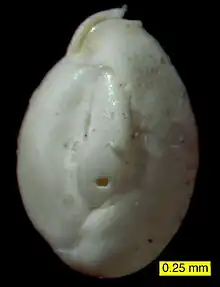Miliolida
The Miliolida are an order of foraminifera with calcareous, porcelacous tests that are imperforate and commonly have a pseudochitinous lining.[2] Tests are composed of randomly oriented calcite needles that have a high proportion of magnesium along with organic material. Tests lack pores and generally have multiple chambers.
| Miliolida Temporal range: Carboniferous - Recent | |
|---|---|
 | |
| Quinqueloculina sp. from Donegal Bay, Ireland. | |
| Scientific classification | |
| Domain: | |
| (unranked): | |
| (unranked): | |
| Phylum: | |
| Subphylum: | |
| Class: | |
| Order: | Miliolida |
| Superfamilies | |
| |
Miliolids, which range from the Carboniferous to recent, are benthic Foraminifera abundant in shallow waters such as in estuaries and along coastlines, though they also include deepwater oceanic forms.[3]
The order Miliolida, sometimes referred to as a suborder, the Miliolina, is divided on the basis of differences in test morphology into five recognized superfamilies.
References
- "Miliolina". WoRMS. World Register of Marine Species. Retrieved 2018-12-04.
- Loeblich, Alfred R.; Tappan, Helen (1964). Moore, R.C. (ed.). Protista 2: Sarcodina Chiefly "Thecamoebians" and Foraminiferida. Treatise on Invertebrate Paleontology. Vol. C (5th ed.). Geological Society of America. pp. 436–510a. ISBN 978-0-8137-3003-5.
- Omaña, L.; Alencaster, G.; Buitrón, B.E. (2016). "Mid-early late Albian foraminiferal assemblage from the El Abra Formation in the El Madroño locality, eastern Valles–San Luis Potosí Platform, Mexico: Paleoenvironmental and paleobiogeographical significance" (PDF). Boletín de la Sociedad Geológica Mexicana. 68 (3): 477–492. doi:10.18268/BSGM2016v68n3a6.
- Pictures of Smaller Miliolids. USF. Retrieved 2009-09-01.
This article is issued from Wikipedia. The text is licensed under Creative Commons - Attribution - Sharealike. Additional terms may apply for the media files.